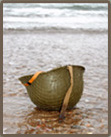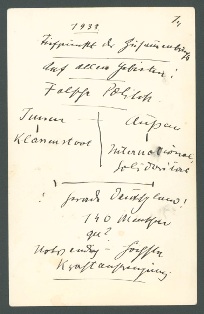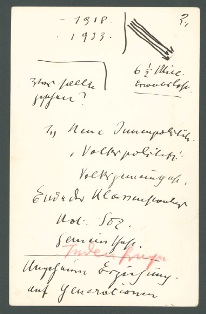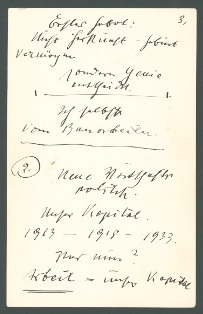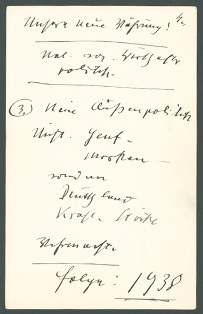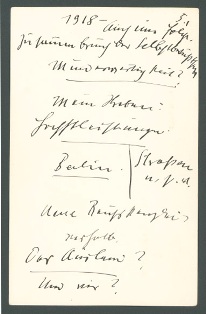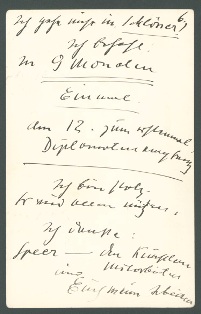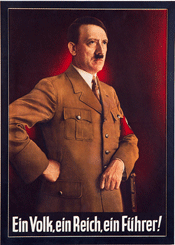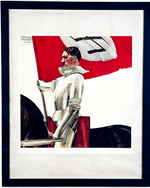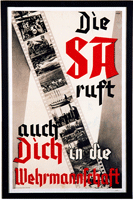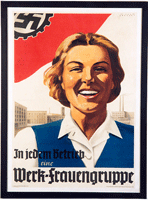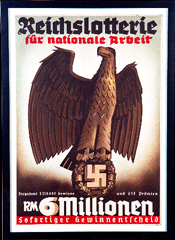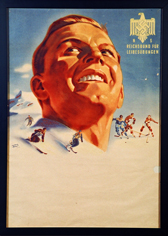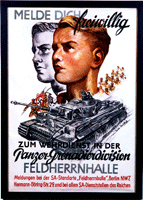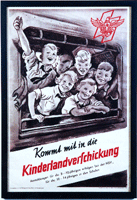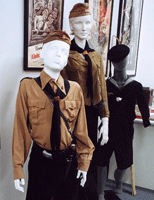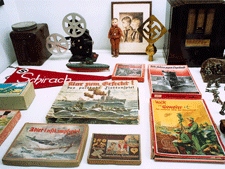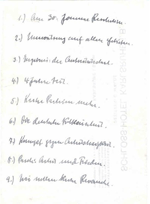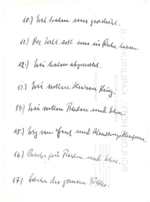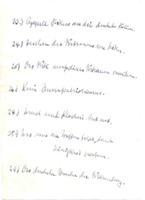ADOLF HITLER AND THE RISE OF NAZISM
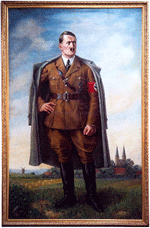
This exhibit is exceptionally powerful in conveying a sense of how the Nazi party rose to power, permeating all areas of German life, especially the young. The museum's collection of personal artifacts of Hitler is truly remarkable. Pictured to the left is the 9' x 12' portrait of Hitler, done in 1937 by Lehmkuhl Von Uhr and presented to Herman Goring by Hitler at the opening of the Reichsministry building in Berlin, where it was displayed.
The first broadside stating the goals of the Nazi party, announcements of rallies in beer halls, the original ballots used to elect Hitler, and election posters are combined with the original manuscripts of Hitler during his rise to power. Letters of Göring and manuscripts of Goebbels concerning important events during the 1920s and 1930s are displayed. The creation of Hitler's image is seen in many posters and other propaganda, as well as presentation photographs. The development of the Hitler Youth is a special exhibit, from toy soldiers and children's war games to the musical instruments and uniforms of the Hitler Youth. |
|
| |
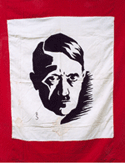
|
The pageantry of Nazism is shown, including a "Deutschland Erwache" (Germany Awaken) standard and banner, an SS glockenspiel, bronze busts of Hitler, a tapestry from the Reichschancellery, Hitler's S.A. shirt, and the large bronze eagle and gold swastika from the speaker's stand at Nuremberg taken as war souvenirs by George Patton. This section concludes with an exhibit of personal artifacts of Hitler, including watercolors, his watch, reading glasses and other personal items. |
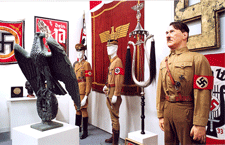
|
|
| |
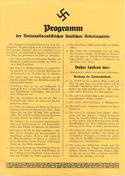 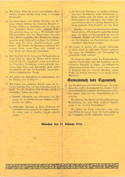
|
Hitler's 25-point plan, creating the Nazi Party, February 1920. |
|
| |
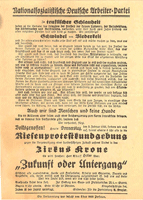 |
Announcement of a protest meeting, Feb. 3, 1921: "With devilish cunning the representatives of the principle of freedom of small nations, of world wide disarmament, of the League of Nations and world peace have succeeded in keeping our people deaf and blind by means of all kinds of hollow phrases. A two year period of pretense of honesty and hypocrisy of peace made our people ready and worn down for that which is now before us." |
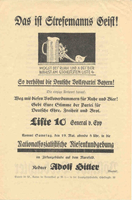 |
Announcement of a Nazi rally for "German honor, freedom and bread." May 19, 1923. |
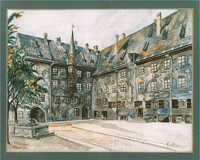 |
Adolf Hitler's watercolor of Die Altar Hof, later given by Hitler to his Chief Adjutant, Wilhelm Bruckner. |
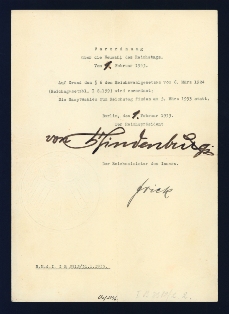 |
Paul von Hindenburg defeated Hitler for the Presidency of Germany in the elections in 1932. Believing that he could control Hitler if within his administration, Hindenburg was convinced to appoint Hitler Chancellor on January 30, 1933. Hitler then demanded that Hindenburg dissolve the Reichstag and call for new elections. Under tremendous pressure, Hindenburg consented and signed the present document decreeing that “a new general election for the Reichstag will take place on March 5, 1933.” The day of this document Hitler broadcast his first national radio address to the German public urging them to vote for the Nazi party and defeat communism. The massive attacks against all opposition culminated in the burning of the Reichstag on February 27, which Hitler blamed on communists, and the Nazi party decisively won the election which Hindenburg had authorized in this present document. This was the last election during the Third Reich. |
|
| |

|
A sketch by Hitler of the Nazi party banner. |
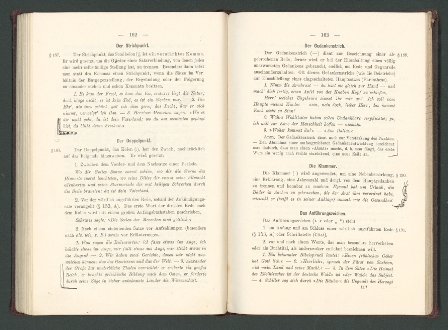 |
Hitler’s schoolboy grammar book with his notes throughout. He drew a frame around the passage “Heartless man say: Wherever you feel comfortable, there is your fatherland; where you are tormented the least, there blooms your freedom”, and underscored the accomplishments of Alexander the Great. |
|
| |
|
| |
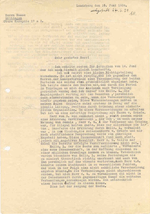
|
Adolf Hitler, letter signed from Landsburg Prison, where he wrote Mein Kampf, June 16, 1924: "I have therefore decided to withdraw from public politics as long as or until I regain my freedom and gain the possibility of total leadership. I must therefore declare to you that no one has the right to act in my name…or to issue declarations in my name." |
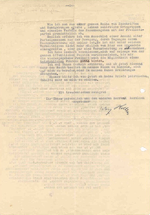
|
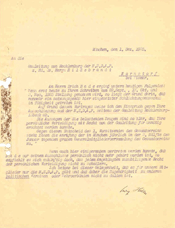 |
Adolf Hitler, letter, December 1, 1925: "There is only the N.S.G.W.P. (National Socialist German Workers' Party)…membership in other political associations and paramilitary units is not to be tolerated." |
|
| |
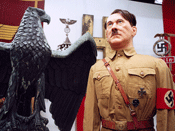
|
HITLER'S SA SHIRT, which was removed by U.S. Captain Frank Qualls from Hitler's apartment on Prinzregentenplatz in Munich, April 30, 1945. Pictured alongside is the Nuremburg Eagle, taken back to the United States by General George S. Patton |
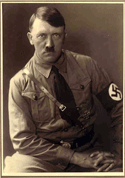
Hitler pictured in the shirt on display.
|
|
| |
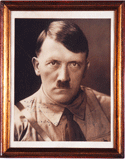
Photograph of Hitler presented to Horst Wessel, in appreciation for the writing of the Nazi Party song, Die Fahne Hoch

Horst Wessel's SA kepie. |
| |
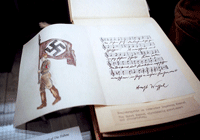
|
Horst Wessel's autographed manuscript of Die Fahne Hoch ("The Great Banner"), with a drawing of an SA trooper. |
|
| |
|
|
| |

|
Bust of Adolf Hitler used by General George Patton as a doorstop. (left)
Hitler's first proclamation to the German people as Chancellor, Berlin, February 1, 1933. "The task with which we are faced is the hardest which has fallen to German statesmen within the memory of man. But we are all filled with unbounded confidence for we believe in our people and their imperishable virtues. Every class and every individual must help us to found the new Reich."
Only one other copy of this proclamation is known. (right) |
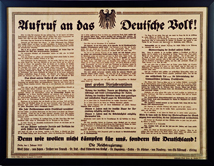
|
|
| |
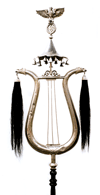
SS Glockenspiel
|
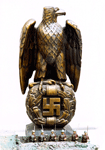 |
Artifacts of the Nazi party era include a Nazi rally banner from 1932 and other fascinating artifacts. |
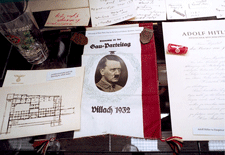
|
|
| |
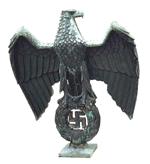
|
Large bronze Nuremberg Eagle taken by General George S. Patton, Jr. as a war souvenir. |
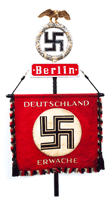
|
Nazi standard, "Deutschland Erwache"(Germany Awaken) |
|
| |
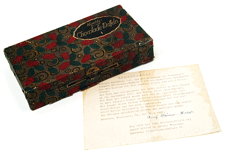
|
This tin of "Kambly's Finest Chocolate Wafers" was a gift from Adolf Hitler to his niece, Geli Raubal, on Sept. 17, 1931--the day before her apparent suicide. It was left with its contents in Geli Raubal's room in Hitler's apartment at 16 Prinzregentenplatz. After her death, the room remained locked and was only accessible to Hitler and Anny Kramer-Winter, Hitler's housekeeper from 1929 to 1945. Up until the beginning of the war, Hitler spent every Christmas Eve alone in this room. |
|
| |
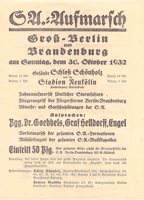
|
Nazi rally in Berlin, October 1932: "Our power increased, yet it is not enough, the Master level is still powerful, headed by Jews. Let us get rid of them. We need your vote to light the fire of the fight against our exploiters...with the people--for the people, we have the power." |
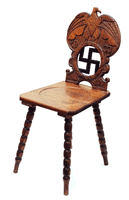
|
Chair made to commemorate the 1933 Nazi victory, from Heinrich Himmler's home in Gmund on the Tegernsee. |
|
| |
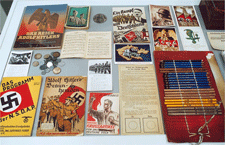 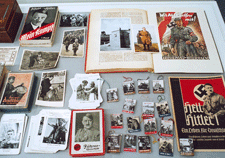
|
| |
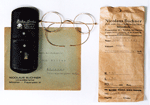
Adolf Hitler's reading glasses.
|
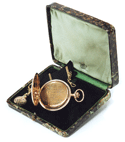
|
Hitler's pocket watch, given to him by his sister Angela and his nieces Friedl and Geli Raubal. Inscribed "to our beloved brother and uncle on his birthday, 20 April 1929, Angela, Geli and Friedl." |
|
| |

|
Hitler's gold pillbox, presented to him on becoming Reich Chancellor. Engraved "The Battle Is Won--The Struggle Grows Wider", January 30, 1933. |
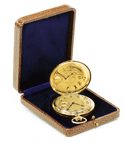
|
Pocket watch presented by Hitler to Georg Winter on his birthday, 1933. |
|
| |
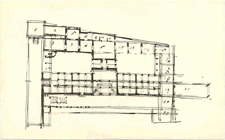 |
Architectural pen and ink drawing by Adolf Hitler. |
|
| |
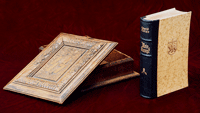
|
Oak Box carved with SS runes, swastika, Hagall-rune, oak leaves and acorns. It contained a presentation copy of Mein Kampf, which every newly-married SS man received. |

|
A wooden locking chest, inscribed with Nazi emblems and slogans. |
|
| |

|
Mein Kampf with an amber cover and silver adornments, presented to "The Best German in Ski-Jumping", International Winter Sports Week, Garmisch-Partenkirchen, 1938 |

Portrait bust of the "perfect German".
|
|
| |

David Lloyd George inscribed this photograph:
"To Chancellor Hitler, with admiration for his brilliant gift of courage."
London, Dec. 1, 1933.
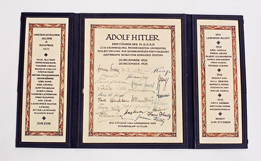
Presentation "To Adolf Hitler, the leader of the NSDAP in commemoration of the first anniversary of his release from disgraceful fortress imprisonments by a dishonorable system—20 December 1924-1920 December 1925" from the leader and comrades of Hitler’s Assault Group. Signed by twenty-three members of the Assault Group, including Rudolf Hess and Herman Goering. |
|
| |

Light bulb with swastika as the filament.
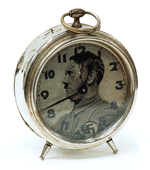
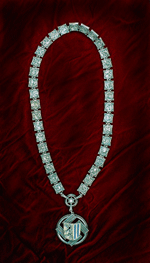
The Mayor of Leipzig's symbol of power.
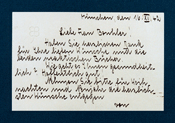
Eva Braun sending Christmas greetings, 1942.
|
|
| |
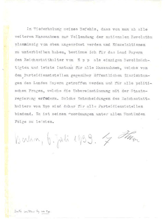
Hitler letter, July 6, 1939: "From now on all further steps toward completing the national revolution will be ordered from above according to plan and individual activities are to cease..."
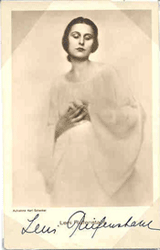
Leni Riefenstahl, photograph.
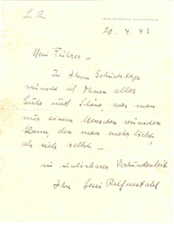
Leni Riefenstahl, the noted Nazi propaganda filmmaker. Intimate letter to Hitler.
|
|
| |
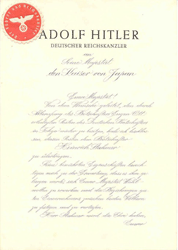
Adolf Hitler to Japanese Emperor Hirohito, January 6, 1943.
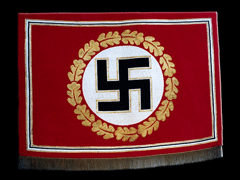
Large tapestry which hung in the Reichschancellery
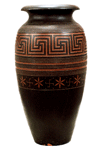
Decorative pot for the anteroom to Hitler's office in the Reichschancellery, made at the Allach Porcelain Works by Dachau concentration camp prisoners.
|
|
| |
HITLER YOUTH
Uniforms of the Hitler Youth. |
|
| |
The collection of toys and figurines show the extent of Nazi influence in the German culture. |
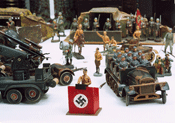  
|
|
| |
 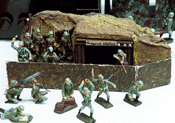
|
| |

|
Bust of Reichsmarschall Herman Goering, head of the German Luftwaffe. |
|
| |
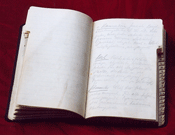
|
Herman Goering's address book, 1935, with his notes on Nazi leaders:."Bormann…very suited for all tasks…hard worker, knows the Fuhrer's goals and methods very well….Himmler, Chief of Police. Very Energetic. Very suited for all tasks. Organizer. Sometimes has certain quirks." |
|
| |
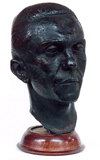
|
Bust of Propaganda Minister Joseph Goebbels. |
|
| |
Joseph Goebbels, autograph manuscript notes for a 1933 speech:
- On January 30 revolution.
- Upheaval in all spheres.
- Result: the authoritarian state.
- 4 years' time.
- No more parties.
- The unity of the German people.
- Fight against unemployment.
- Slogan: Work and Peace.
- We don't want revenge.
- We have done nothing but work...
- The world should leave us alone.
- We disarmed.
- We don't want war.
- We want peace and honor.
- Away from Geneva and disarmament conference.
- Slogan: For Peace and Honor.
- A cause of the entire people.
- We will sign nothing which is against honor.
- We want a lasting peace.
- They may not treat us as pariahs.
- The whole people must declare its loyalty before the world.
- We are preparing the way for a new Europe.
- Appeal by Hitler to the German nation.
- Token of trust by Hitler.
- The people must return his trust.
- No chauvinism.
- What is needed is seriousness and clarity.
- What we lack in weapons we'll make up for through unity.
- The German miracle of coming together of a people.
|
|
| |
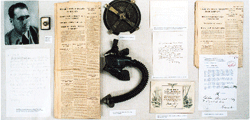 |
This exhibit includes a piece taken from Hess' plane; his oxygen mask used in his flight; a note from Hess, specifing which two prisoners he wanted present when he was interrogated; and other artifacts regarding Hess. |
|
| |
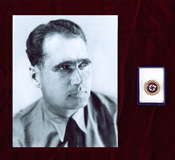
Deputy Fuhrer Rudolf Hess and his Nazi Party pin.
|
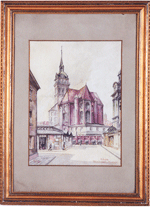
|
Hitler's watercolor of the Farmer's Market at St. Peter's Church in Munich, which was presented to Rudolf Hess. |
|
| |
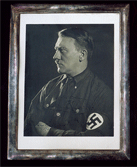 |
"Dedicated to my loyal comrade Hess, in thankful remembrance of our dual labor together. Adolf Hitler, Munich, 26 April 1928." Hess voluntarily accompanied Hitler to Landsburg Prison, where Hitler dictated Mein Kampf to him. Hitler presented this photograph to Hess. |
|

